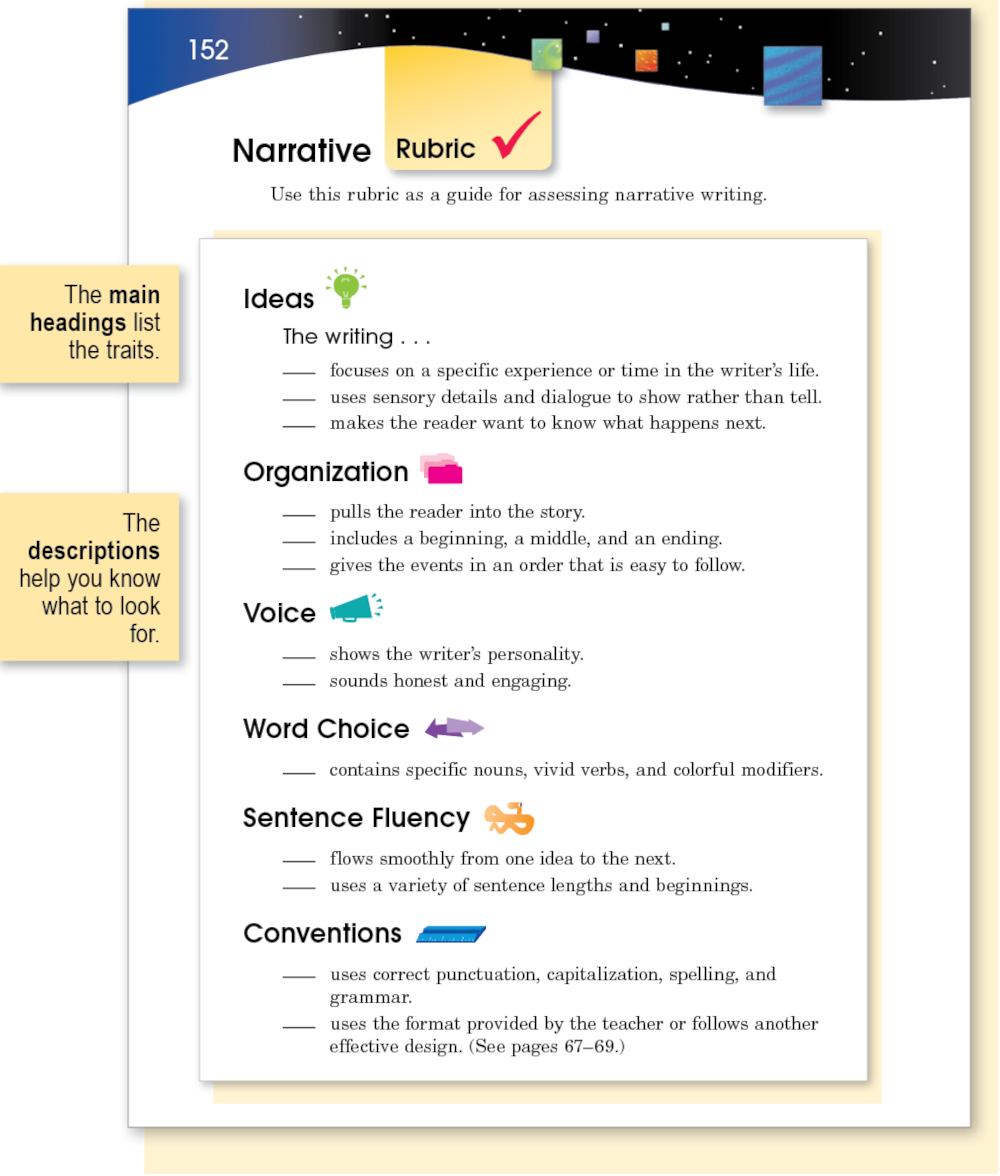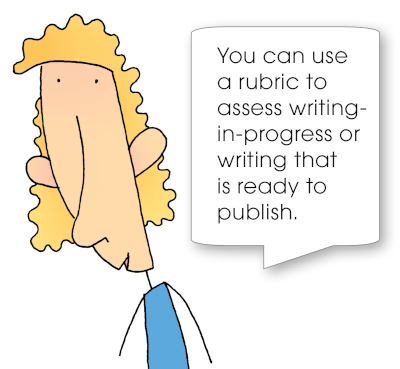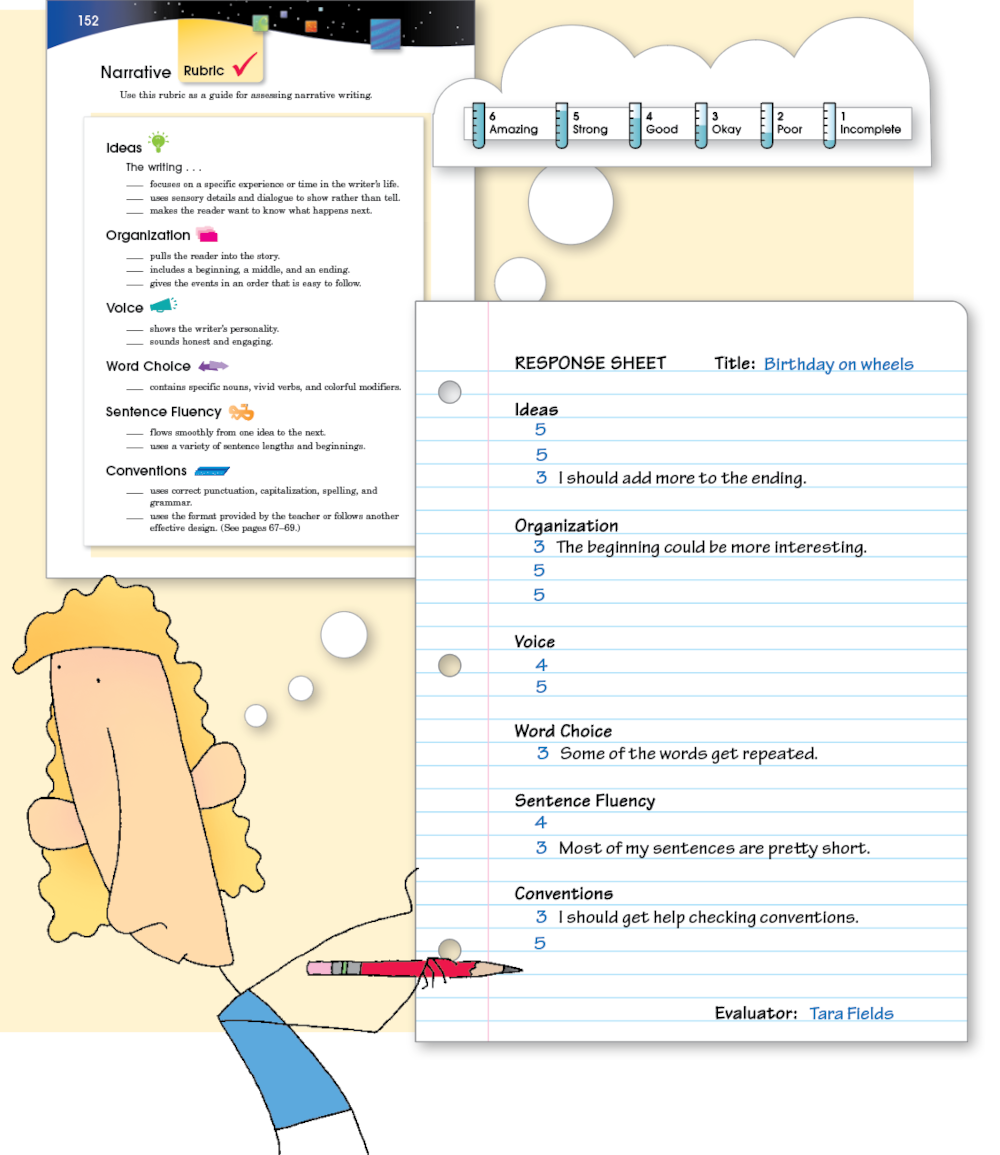WOC 023
Page 23
Using Rubrics

The original Star Wars movies were terrific! Some of the prequels and sequels were less so. Writers and directors thought special effects were the key. They forgot about having characters that people cared about, stuck in situations over their heads, doing their best to save the day, heroically (and humorously) struggling against the Dark Side. If writers and directors had focused on those traits as well as special effects, they would have made stronger follow-on movies. They needed a Star Wars rubric.
Luckily as a writer, you have rubrics to help you focus your efforts. On a single sheet of paper, you can see all the traits of an effective assignment. Write on Course contains trait-based rubrics for narrative, explanatory, and persuasive (argument) writing as well as for responding to literature. You can use these rubrics from start to finish as you develop your writing.
What’s Ahead
WOC 024
Page 24
Understanding Rubrics
A rubric helps you evaluate the quality of writing. The rubric for narrative writing (page 152) is shown below.

WOC 025
Page 25
Using a Rubric
To assess your writing with a rubric, use either the check-mark method or the numbering method.
Using Check Marks
When your writing matches a description, check it off. Then review the checklist to see what work you still need to do. In this sample assessment, the narrative could use more dialogue and sensory details.

Using Numbers
You can also use numbers to rate the effectiveness of the writing for each description. Here is one rating scale that you could use.

In the sample assessment, the number 3 indicates that the narrative contains some dialogue and sensory details, but it needs more to move from “Okay” to “Good.”

WOC 026

Page 26
Assessing in Action
In the following narrative, student writer Tara Fields tells about her first time skating. Read the narrative. What parts do you like? What parts do you have questions about? (The writing does contain errors.) Then on page 27, you can see how Tara used the narrative rubric to assess her writing.
Narrative Essay
Birthday on Wheels
I arrived at InTowne Skate all exited for Alice’s birthday party. I’d never been skating before, but Alice said it was fun, and I couldn’t wait to try it.
I got a pare of skates in my size and sat on a bench to cinch them up. I stood up slowly, shuffling the skates on the low-pile carpet. “Not too bad.”
Alice skated by, smoothe as a dancer. “Come on, Tara! Let’s get out there!” She rolled onto the rink, turned a little circle, and skated away backward. What fun!
I shambled my way acrost the carpet to the rink entrance and then launched onto the bare floor.
Sudddenly, I was on my backside.
What happened? Struggling to my knees, I crawled to a half-wall and pulled myself up. “Now, focus!” I ventured a foot out and went down again. “Ow!”
Alice wheeled passed. “Keep going! You’ll get used to it!”
I spent the next ten minutes hugging the wall and straggling along. After one complete loop, I went out again. My legs went flying in different directions like Bambi on ice.
Down I went, again.
I didn’t have a very good opinion of skating, and my backside was absolutely against it.
Then Alice came over and held out her hands. “Let’s do a lap together.” Herky-jerky, we made our way around the rink, and with Alice’s help, I stayed on my feet the whole time.
“You ready to try solo? she asked.
Struggling toward the exit, I said, “I’m ready to try birthday cake!”
WOC 027
Page 27
Assessment
To evaluate her narrative (on the previous page), Tara first made a response sheet on her own paper. Then she assessed her writing using the rubric on page 152 as a guide. She used numbers to rate her writing and added comments to explain some of her ratings.

WOC 028
Page 28
Evaluating Tips
Get the most out of rubrics by following the tips below.
Getting Started
- Don’t assess until you have a complete draft—with a beginning, a middle, and an ending. (You can assess first drafts, final drafts, and anything in between.)
- Use the appropriate rubric. Write on Course provides rubrics for narrative, explanatory, and persuasive writing, as well as responding to literature.
Reading and Reviewing
- Review the rubric so you know what features to look for.
- Carefully read your work at least two or three times—once for an overall impression and the other times for specific traits.
- Ask a peer to review your writing as well.
Helpful Hint
When you are assessing a classmate’s work, keep your comments positive and helpful. Say “I’d like to know more details about this concert” rather than “You hardly describe the concert at all!”
Making Your Evaluation
- Make your evaluation on a copy of the rubric provided by your teacher or on your own response sheet. (See page 27.)
- Use either check marks or numbers to rate each item. (If you’re not sure what to do, ask your teacher.)
- Add comments to your ratings as needed.
Following Up
- For a work-in-progress, use your evaluation to revise.
- For a final evaluation, decide which traits (ideas, voice, . . .) you need to work on in the future.
- If you have evaluated someone else’s writing, be ready to answer questions or give suggestions.